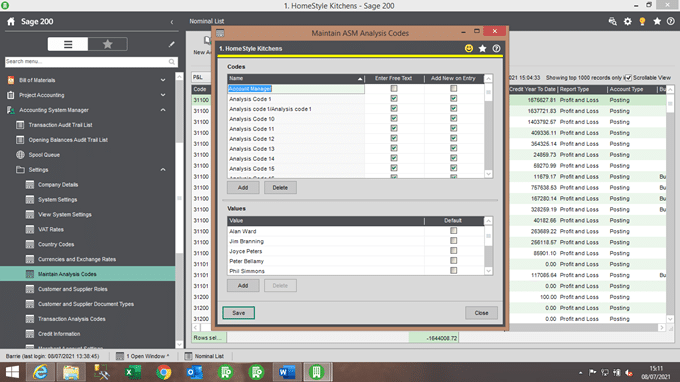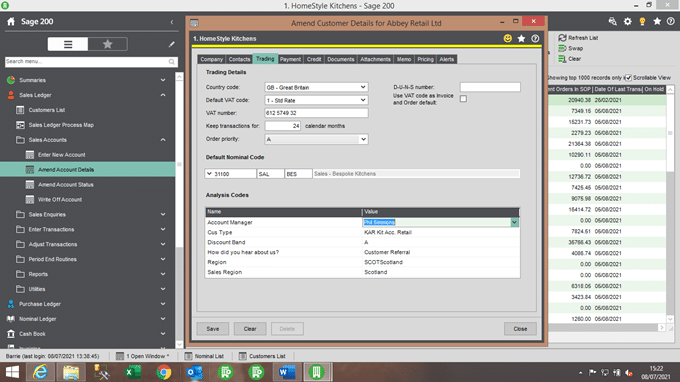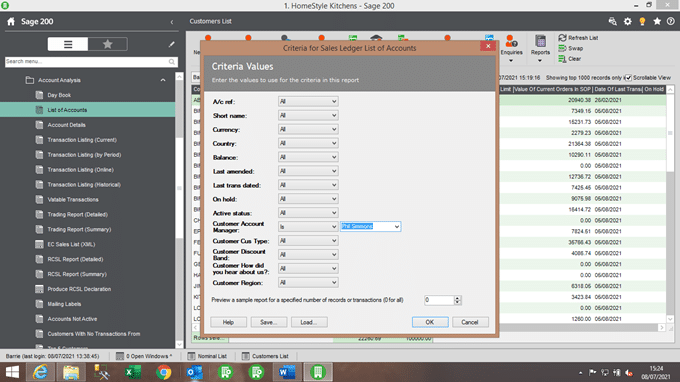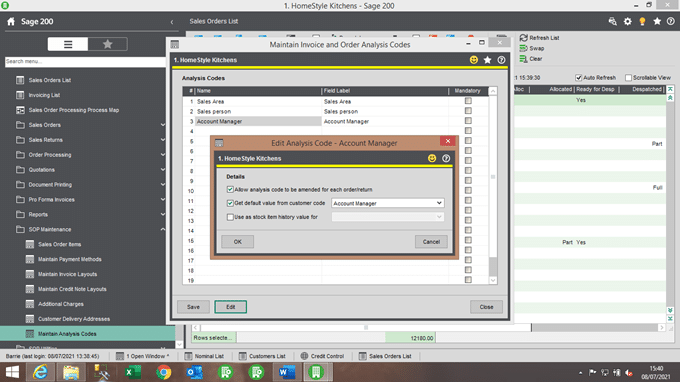Blogs & News
Analysis codes to identify accounts for enquiry & reporting
3 December 2021

Summary – How to identify accounts for enquiry & reporting
Analysis codes can be used to identify accounts for enquiry and reporting purposes.
Examples of a sales ledger (customer account) analysis code might be:
- Account manager
- Customer account type
- Credit controller
What does using analysis codes to identify accounts for enquiry & reporting do?
Using analysis codes helps users to identify accounts and run reports for or to display lists of specific customer accounts based on their analysis code(s).
Storage Preferences – selected if printed and/or emailed documents are to be stored.
How do I do this?
SET UP ANALYSIS CODES
There are 3 steps to applying analysis codes to customer accounts:
- Set up the analysis codes in the central analysis code table
- Set the analysis codes to be used in the sales ledger
- Apply analysis codes to customer accounts
1. Set up the analysis codes in the central analysis code table
- Accounting System Manager >> Settings >> Maintain Analysis Codes
- Note: this central analysis codes table is used to hold analysis codes for all modules.
- In the Codes top panel, click Add and enter the name / heading of your analysis code, for example ‘Account Manager’.
- Ensure the heading is selected (highlighted), then in the bottom panel enter the Values – these will be items a user can select for the analysis code, for example a list of the account manager names.
- In the next section when you add this to sales ledger there is an option to make the analysis code Mandatory – if you will select that this will be a mandatory field then you must select one of the values here to be a default.
- There are 2 options that can be selected in the top panel:
~ Enter Free Text = allows a user to enter text in the analysis field on the customer rather than select from the list created in the bottom panel; if you are using the analysis codes to run report or list filters you would not usually tick this box; if you are using the analysis code for entry of a general note or item of information then you will tick this box
~ Add New On Entry = users can add new ‘values’ to this table from the customer analysis field, rather than having to open this set-up screen and adding a new ‘value’ here.
- When you have entered your analysis codes click Save.

2. Set analysis codes to be used in the sales ledger
- Sales Ledger >> Utilities >> Ledger Set Up >> Maintain Analysis Codes
- Name = use the drop-down list to select the analysis code you entered above
- Field Label = enter the field name you want to see on the customer account screens – this will often be the same name you used when you created the analysis code, though it can be different
- Mandatory = tick if you want this to be a mandatory field on customer account records; when ticked a user cannot save a new account without entering a value; with existing customer accounts if you make it mandatory it will only make users select a value when they are amending a customer account and want to save.
- Click Save.
- Within the Remittances folder you will find the saved remittances as .pdf documents, the name of each document includes the date and time it was saved.

3. Apply analysis codes to customer accounts
- Sales Ledger >> Sales Accounts >> Enter New Account > Trading tab.
- Sales Ledger >> Sales Accounts >> Amend Account Details > Trading tab.
- Select the value you require for the analysis code, or if free text was enabled enter the note / text.

USING ANALYSIS CODES
Reports
Many reports can now be run for the analysis code.

For example:
- List of accounts
- Account Details
- Aged Debtors (Detailed)
If a report you want to filter by an analysis code does not have this option on the report criteria screen, please contact the helpdesk as for many reports this can be very easily added as an option.
Customer List
Sales Ledger >. Customers List
Right-click in the Customer List panel, highlight Columns from the pop-up menu, then highlight Analysis, and select the analysis code(s).
Back on the customer list you can re-position the column by using drag-and-drop on the column heading.
Use the Filter option above the list to create a filter on your analysis code, or click the column heading to sort the rows in ascending or descending order based on your analysis code.
Workspace Enquiries
Workspaces >> Sales Ledger
Like the customer list above, analysis codes can be added to lists of customers; in a workspace panel right-click then select Column Selector from the pop-up menu; add your Analysis Code and position it where you want.
Additional Information
Export and Import
Sage 200 version Spring 2019 / v12.00.0031 introduced a new feature of Export and Import where you can export all customer account details, amend those details in Excel, then import those changes back into the sales ledger – this can be used to upload and amend analysis code values in bulk from Excel.
Sales Ledger >> Utilities >> Import >> Export Accounts and Sales Ledger >> Utilities >> Import >> Import Accounts
Sales Order Processing
If you are using Sales Order Processing module and would like the analysis codes from the customer account to populate to the analysis codes on the sales order, use the sales order processing analysis codes table like the sales ledger above, though you will also see an edit button on the sales order table, which allows the analysis code values to be pulled through to the order.

Further Information
If you have any questions about this or need assistance, then please contact the GCC Group Support Team on 0345 260 1151 or servicedesk@gccgroup.co.uk
